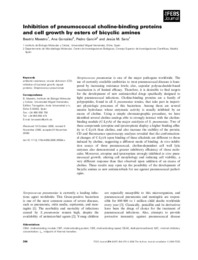Please use this identifier to cite or link to this item:
https://hdl.handle.net/11000/30955Full metadata record
| DC Field | Value | Language |
|---|---|---|
| dc.contributor.author | Maestro García-Donas, Beatriz | - |
| dc.contributor.author | Gónzalez, Ana | - |
| dc.contributor.author | García, Jesús | - |
| dc.contributor.author | Sanz, Jesús M. | - |
| dc.date.accessioned | 2024-02-02T09:38:08Z | - |
| dc.date.available | 2024-02-02T09:38:08Z | - |
| dc.date.created | 2006 | - |
| dc.identifier.citation | FEBS Journal . 2007 Jan;274(2):364-76 | es_ES |
| dc.identifier.issn | 1873-3468 | - |
| dc.identifier.issn | 0014-5793 | - |
| dc.identifier.uri | https://hdl.handle.net/11000/30955 | - |
| dc.description.abstract | Streptococcus pneumoniae is one of the major pathogens worldwide. The use of currently available antibiotics to treat pneumococcal diseases is hampered by increasing resistance levels; also, capsular polysaccharide-based vaccination is of limited efficacy. Therefore, it is desirable to find targets for the development of new antimicrobial drugs specifically designed to fight pneumococcal infections. Choline-binding proteins are a family of polypeptides, found in all S. pneumoniae strains, that take part in important physiologic processes of this bacterium. Among them are several murein hydrolases whose enzymatic activity is usually inhibited by an excess of choline. Using a simple chromatographic procedure, we have identified several choline analogs able to strongly interact with the choline-binding module (C-LytA) of the major autolysin of S. pneumoniae. Two of these compounds (atropine and ipratropium) display a higher binding affinity to C-LytA than choline, and also increase the stability of the protein. CD and fluorescence spectroscopy analyses revealed that the conformational changes of C-LytA upon binding of these alkaloids are different to those induced by choline, suggesting a different mode of binding. In vitro inhibition assays of three pneumococcal, choline-dependent cell wall lytic enzymes also demonstrated a greater inhibitory efficiency of those molecules. Moreover, atropine and ipratropium strongly inhibited in vitro pneumococcal growth, altering cell morphology and reducing cell viability, a very different response than that observed upon addition of an excess of choline. These results may open up the possibility of the development of bicyclic amines as new antimicrobials for use against pneumococcal pathologies. | es_ES |
| dc.format | application/pdf | es_ES |
| dc.format.extent | 13 | es_ES |
| dc.language.iso | eng | es_ES |
| dc.publisher | Willey | es_ES |
| dc.rights | info:eu-repo/semantics/openAccess | es_ES |
| dc.rights.uri | http://creativecommons.org/licenses/by-nc-nd/4.0/ | * |
| dc.subject | antibiotic resistance | es_ES |
| dc.subject | circular dichroism (CD) | es_ES |
| dc.subject | inhibition of bacterial growth | es_ES |
| dc.subject | repeat proteins | es_ES |
| dc.subject | Streptococcus pneumoniae | es_ES |
| dc.title | Inhibition of pneumococcal choline-binding proteins and cell growth by esters of bicyclic amines | es_ES |
| dc.type | info:eu-repo/semantics/article | es_ES |
| dc.contributor.institute | Institutos de la UMH::Instituto de Bioingeniería | es_ES |
| dc.relation.publisherversion | https://doi.org/10.1111/j.1742-4658.2006.05584.x | es_ES |

View/Open:
Inhibition of pneumococcal choline-binding proteins.pdf
1,3 MB
Adobe PDF
Share:
.png)
